Research Project on Financial Instruments in the Solar Energy Sector
VerifiedAdded on 2021/05/31
|33
|6626
|22
Report
AI Summary
This research project delves into the impact of financial instruments within the solar energy sector, analyzing data collected from 50 respondents and 5 managers. The report includes a detailed frequency analysis, examining age groups, roles within companies, and professional backgrounds, alongside the perceived benefits of financial instruments such as insurance and subsidies. Correlation and Chi-square tests are conducted to explore relationships between variables. Interview results from managers provide additional insights. The study assesses how financial instruments influence capital investment, customer relationships, and the development of finance-based policies within the renewable energy sector. The report concludes with recommendations and suggestions for future research, offering a comprehensive overview of the financial dynamics in the solar energy industry.
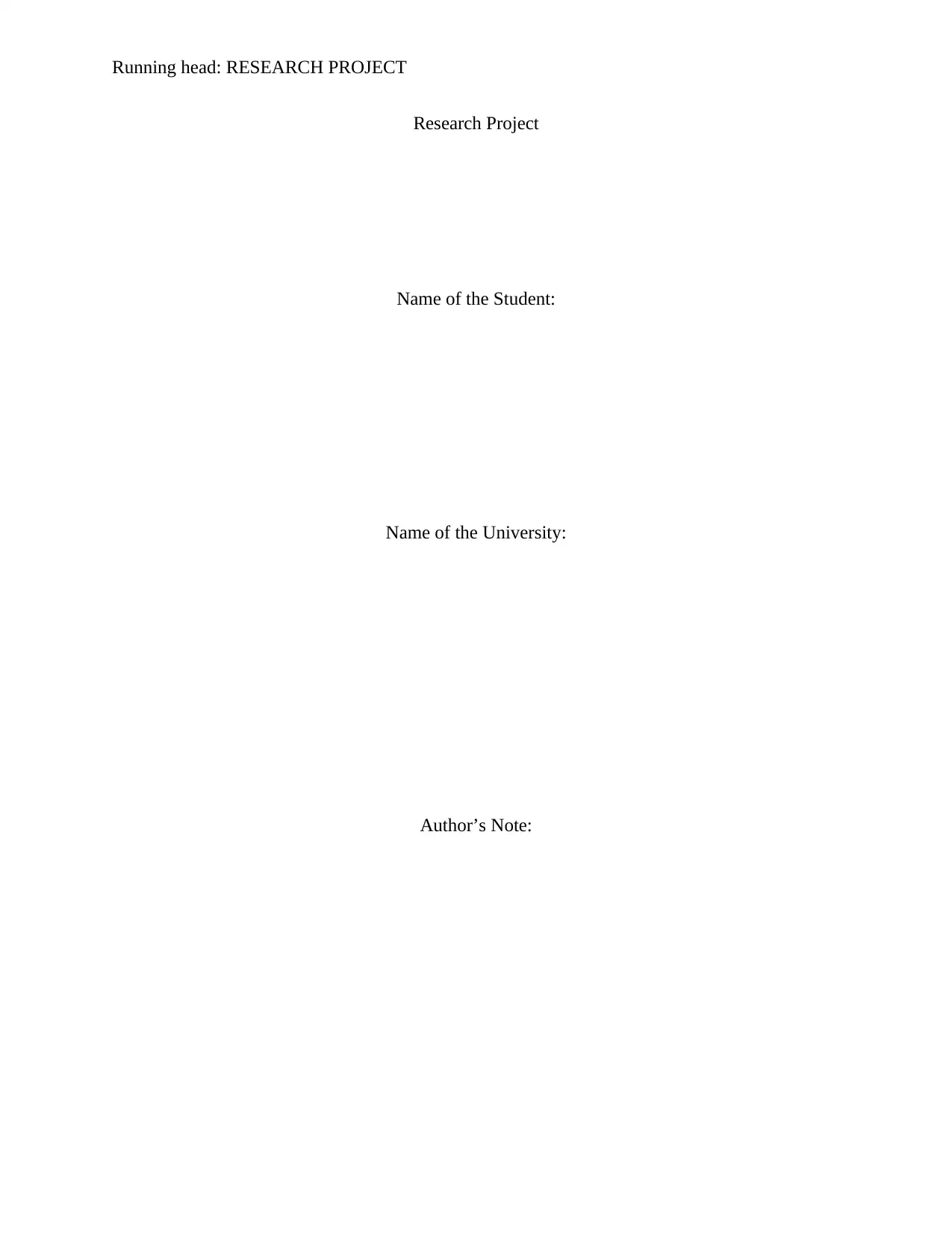
Running head: RESEARCH PROJECT
Research Project
Name of the Student:
Name of the University:
Author’s Note:
Research Project
Name of the Student:
Name of the University:
Author’s Note:
Paraphrase This Document
Need a fresh take? Get an instant paraphrase of this document with our AI Paraphraser
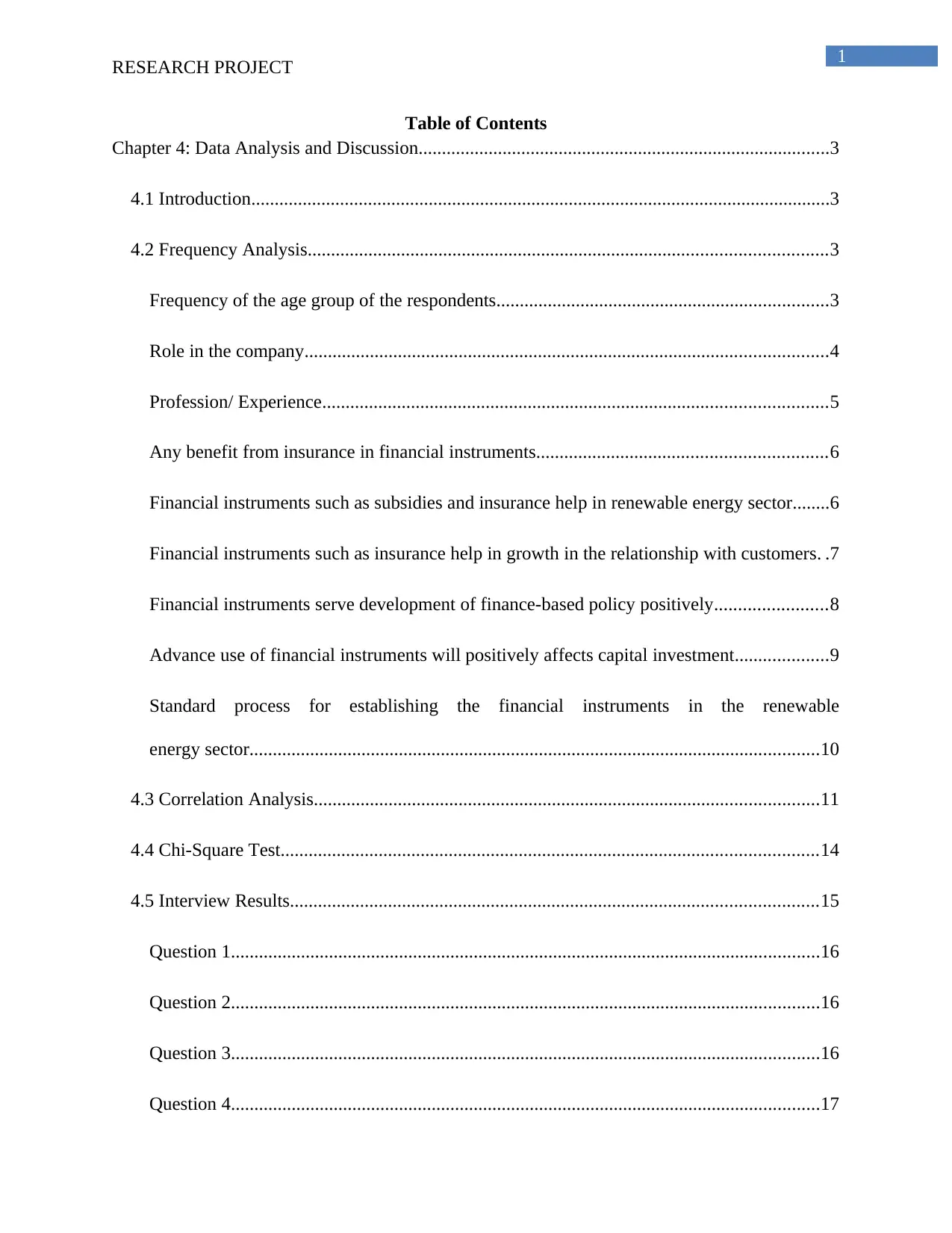
1
RESEARCH PROJECT
Table of Contents
Chapter 4: Data Analysis and Discussion........................................................................................3
4.1 Introduction............................................................................................................................3
4.2 Frequency Analysis...............................................................................................................3
Frequency of the age group of the respondents.......................................................................3
Role in the company................................................................................................................4
Profession/ Experience............................................................................................................5
Any benefit from insurance in financial instruments..............................................................6
Financial instruments such as subsidies and insurance help in renewable energy sector........6
Financial instruments such as insurance help in growth in the relationship with customers. .7
Financial instruments serve development of finance-based policy positively........................8
Advance use of financial instruments will positively affects capital investment....................9
Standard process for establishing the financial instruments in the renewable
energy sector..........................................................................................................................10
4.3 Correlation Analysis............................................................................................................11
4.4 Chi-Square Test...................................................................................................................14
4.5 Interview Results.................................................................................................................15
Question 1..............................................................................................................................16
Question 2..............................................................................................................................16
Question 3..............................................................................................................................16
Question 4..............................................................................................................................17
RESEARCH PROJECT
Table of Contents
Chapter 4: Data Analysis and Discussion........................................................................................3
4.1 Introduction............................................................................................................................3
4.2 Frequency Analysis...............................................................................................................3
Frequency of the age group of the respondents.......................................................................3
Role in the company................................................................................................................4
Profession/ Experience............................................................................................................5
Any benefit from insurance in financial instruments..............................................................6
Financial instruments such as subsidies and insurance help in renewable energy sector........6
Financial instruments such as insurance help in growth in the relationship with customers. .7
Financial instruments serve development of finance-based policy positively........................8
Advance use of financial instruments will positively affects capital investment....................9
Standard process for establishing the financial instruments in the renewable
energy sector..........................................................................................................................10
4.3 Correlation Analysis............................................................................................................11
4.4 Chi-Square Test...................................................................................................................14
4.5 Interview Results.................................................................................................................15
Question 1..............................................................................................................................16
Question 2..............................................................................................................................16
Question 3..............................................................................................................................16
Question 4..............................................................................................................................17
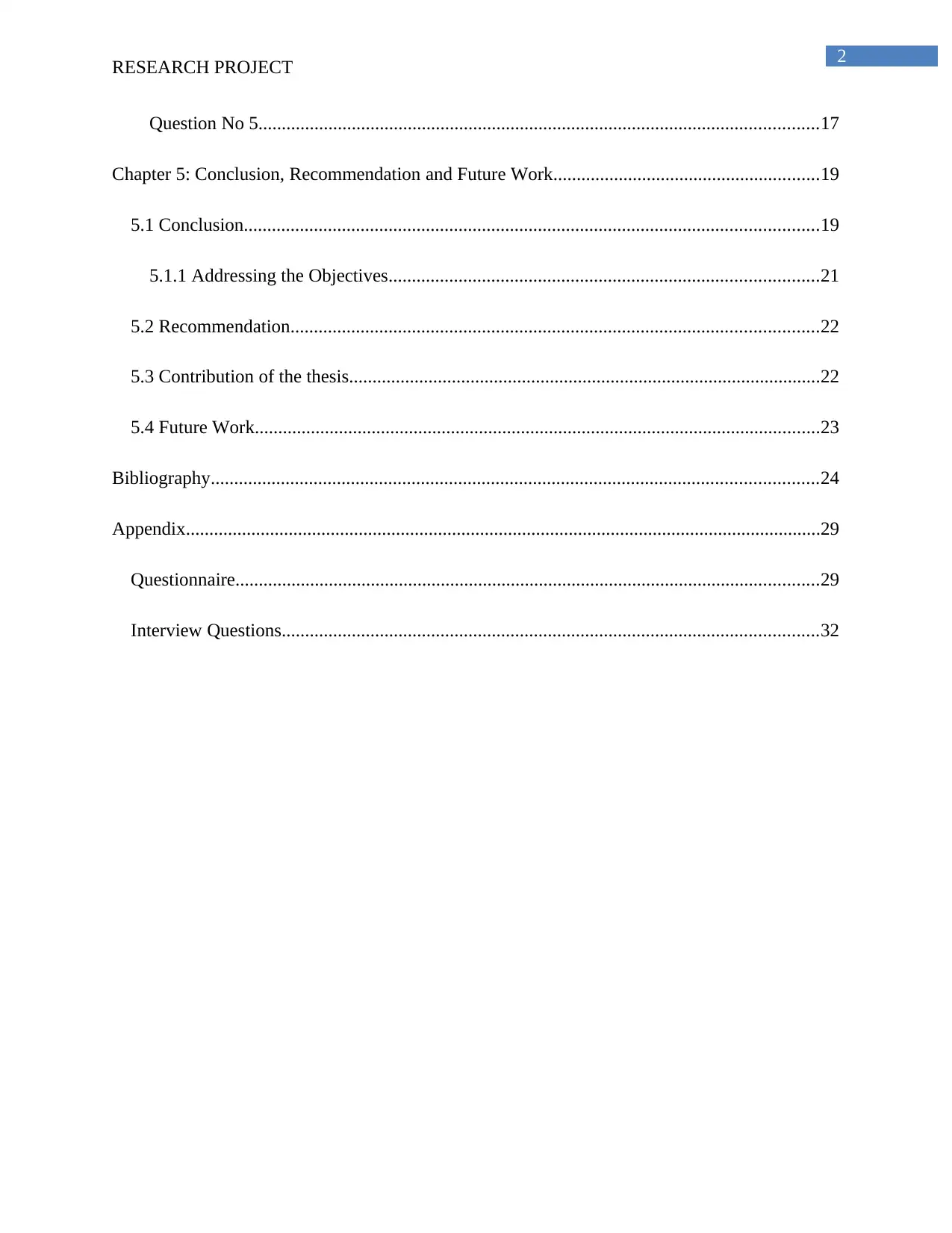
2
RESEARCH PROJECT
Question No 5........................................................................................................................17
Chapter 5: Conclusion, Recommendation and Future Work.........................................................19
5.1 Conclusion...........................................................................................................................19
5.1.1 Addressing the Objectives............................................................................................21
5.2 Recommendation.................................................................................................................22
5.3 Contribution of the thesis.....................................................................................................22
5.4 Future Work.........................................................................................................................23
Bibliography..................................................................................................................................24
Appendix........................................................................................................................................29
Questionnaire.............................................................................................................................29
Interview Questions...................................................................................................................32
RESEARCH PROJECT
Question No 5........................................................................................................................17
Chapter 5: Conclusion, Recommendation and Future Work.........................................................19
5.1 Conclusion...........................................................................................................................19
5.1.1 Addressing the Objectives............................................................................................21
5.2 Recommendation.................................................................................................................22
5.3 Contribution of the thesis.....................................................................................................22
5.4 Future Work.........................................................................................................................23
Bibliography..................................................................................................................................24
Appendix........................................................................................................................................29
Questionnaire.............................................................................................................................29
Interview Questions...................................................................................................................32
⊘ This is a preview!⊘
Do you want full access?
Subscribe today to unlock all pages.

Trusted by 1+ million students worldwide
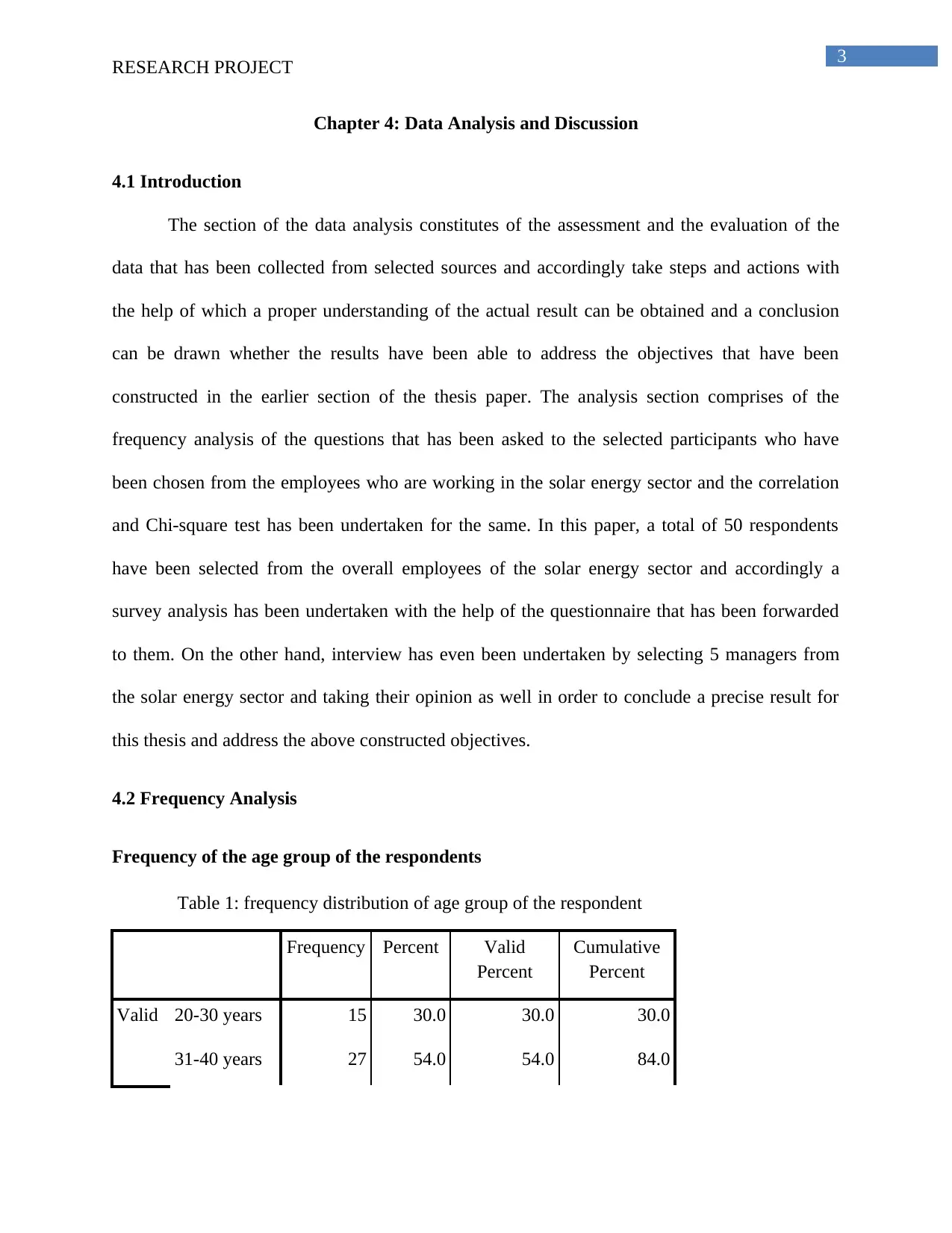
3
RESEARCH PROJECT
Chapter 4: Data Analysis and Discussion
4.1 Introduction
The section of the data analysis constitutes of the assessment and the evaluation of the
data that has been collected from selected sources and accordingly take steps and actions with
the help of which a proper understanding of the actual result can be obtained and a conclusion
can be drawn whether the results have been able to address the objectives that have been
constructed in the earlier section of the thesis paper. The analysis section comprises of the
frequency analysis of the questions that has been asked to the selected participants who have
been chosen from the employees who are working in the solar energy sector and the correlation
and Chi-square test has been undertaken for the same. In this paper, a total of 50 respondents
have been selected from the overall employees of the solar energy sector and accordingly a
survey analysis has been undertaken with the help of the questionnaire that has been forwarded
to them. On the other hand, interview has even been undertaken by selecting 5 managers from
the solar energy sector and taking their opinion as well in order to conclude a precise result for
this thesis and address the above constructed objectives.
4.2 Frequency Analysis
Frequency of the age group of the respondents
Table 1: frequency distribution of age group of the respondent
Frequency Percent Valid
Percent
Cumulative
Percent
Valid 20-30 years 15 30.0 30.0 30.0
31-40 years 27 54.0 54.0 84.0
RESEARCH PROJECT
Chapter 4: Data Analysis and Discussion
4.1 Introduction
The section of the data analysis constitutes of the assessment and the evaluation of the
data that has been collected from selected sources and accordingly take steps and actions with
the help of which a proper understanding of the actual result can be obtained and a conclusion
can be drawn whether the results have been able to address the objectives that have been
constructed in the earlier section of the thesis paper. The analysis section comprises of the
frequency analysis of the questions that has been asked to the selected participants who have
been chosen from the employees who are working in the solar energy sector and the correlation
and Chi-square test has been undertaken for the same. In this paper, a total of 50 respondents
have been selected from the overall employees of the solar energy sector and accordingly a
survey analysis has been undertaken with the help of the questionnaire that has been forwarded
to them. On the other hand, interview has even been undertaken by selecting 5 managers from
the solar energy sector and taking their opinion as well in order to conclude a precise result for
this thesis and address the above constructed objectives.
4.2 Frequency Analysis
Frequency of the age group of the respondents
Table 1: frequency distribution of age group of the respondent
Frequency Percent Valid
Percent
Cumulative
Percent
Valid 20-30 years 15 30.0 30.0 30.0
31-40 years 27 54.0 54.0 84.0
Paraphrase This Document
Need a fresh take? Get an instant paraphrase of this document with our AI Paraphraser
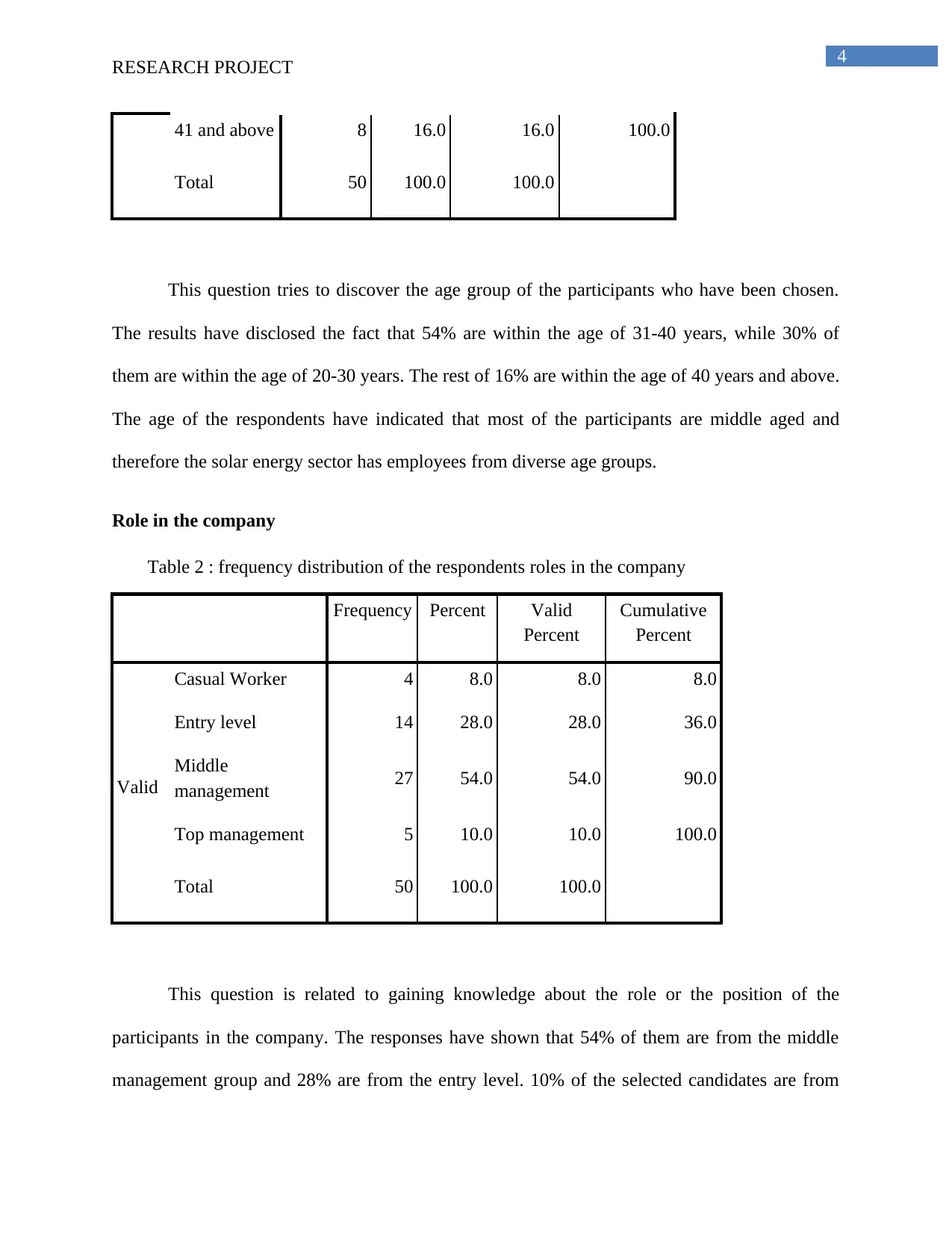
4
RESEARCH PROJECT
41 and above 8 16.0 16.0 100.0
Total 50 100.0 100.0
This question tries to discover the age group of the participants who have been chosen.
The results have disclosed the fact that 54% are within the age of 31-40 years, while 30% of
them are within the age of 20-30 years. The rest of 16% are within the age of 40 years and above.
The age of the respondents have indicated that most of the participants are middle aged and
therefore the solar energy sector has employees from diverse age groups.
Role in the company
Table 2 : frequency distribution of the respondents roles in the company
Frequency Percent Valid
Percent
Cumulative
Percent
Valid
Casual Worker 4 8.0 8.0 8.0
Entry level 14 28.0 28.0 36.0
Middle
management 27 54.0 54.0 90.0
Top management 5 10.0 10.0 100.0
Total 50 100.0 100.0
This question is related to gaining knowledge about the role or the position of the
participants in the company. The responses have shown that 54% of them are from the middle
management group and 28% are from the entry level. 10% of the selected candidates are from
RESEARCH PROJECT
41 and above 8 16.0 16.0 100.0
Total 50 100.0 100.0
This question tries to discover the age group of the participants who have been chosen.
The results have disclosed the fact that 54% are within the age of 31-40 years, while 30% of
them are within the age of 20-30 years. The rest of 16% are within the age of 40 years and above.
The age of the respondents have indicated that most of the participants are middle aged and
therefore the solar energy sector has employees from diverse age groups.
Role in the company
Table 2 : frequency distribution of the respondents roles in the company
Frequency Percent Valid
Percent
Cumulative
Percent
Valid
Casual Worker 4 8.0 8.0 8.0
Entry level 14 28.0 28.0 36.0
Middle
management 27 54.0 54.0 90.0
Top management 5 10.0 10.0 100.0
Total 50 100.0 100.0
This question is related to gaining knowledge about the role or the position of the
participants in the company. The responses have shown that 54% of them are from the middle
management group and 28% are from the entry level. 10% of the selected candidates are from
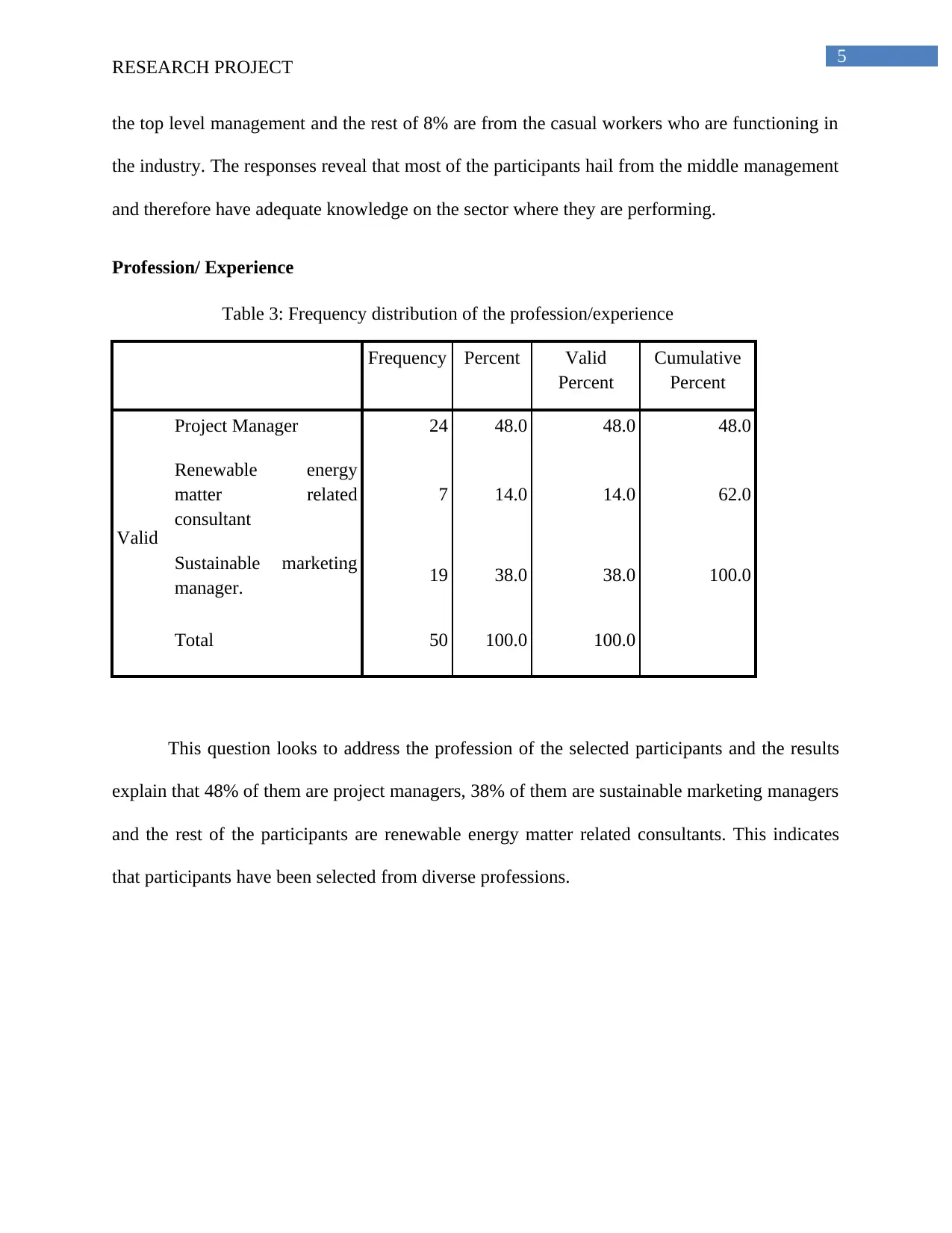
5
RESEARCH PROJECT
the top level management and the rest of 8% are from the casual workers who are functioning in
the industry. The responses reveal that most of the participants hail from the middle management
and therefore have adequate knowledge on the sector where they are performing.
Profession/ Experience
Table 3: Frequency distribution of the profession/experience
Frequency Percent Valid
Percent
Cumulative
Percent
Valid
Project Manager 24 48.0 48.0 48.0
Renewable energy
matter related
consultant
7 14.0 14.0 62.0
Sustainable marketing
manager. 19 38.0 38.0 100.0
Total 50 100.0 100.0
This question looks to address the profession of the selected participants and the results
explain that 48% of them are project managers, 38% of them are sustainable marketing managers
and the rest of the participants are renewable energy matter related consultants. This indicates
that participants have been selected from diverse professions.
RESEARCH PROJECT
the top level management and the rest of 8% are from the casual workers who are functioning in
the industry. The responses reveal that most of the participants hail from the middle management
and therefore have adequate knowledge on the sector where they are performing.
Profession/ Experience
Table 3: Frequency distribution of the profession/experience
Frequency Percent Valid
Percent
Cumulative
Percent
Valid
Project Manager 24 48.0 48.0 48.0
Renewable energy
matter related
consultant
7 14.0 14.0 62.0
Sustainable marketing
manager. 19 38.0 38.0 100.0
Total 50 100.0 100.0
This question looks to address the profession of the selected participants and the results
explain that 48% of them are project managers, 38% of them are sustainable marketing managers
and the rest of the participants are renewable energy matter related consultants. This indicates
that participants have been selected from diverse professions.
⊘ This is a preview!⊘
Do you want full access?
Subscribe today to unlock all pages.

Trusted by 1+ million students worldwide
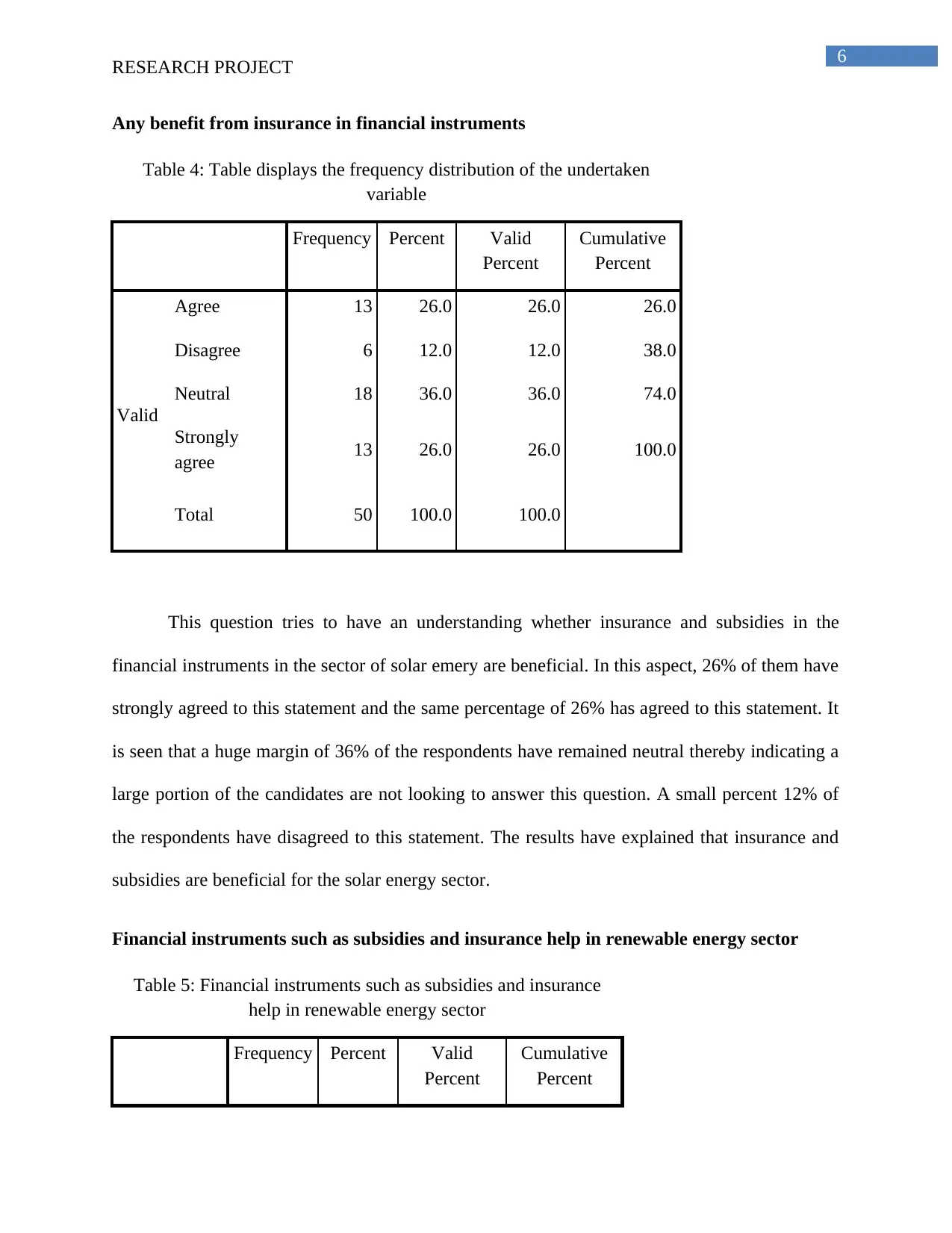
6
RESEARCH PROJECT
Any benefit from insurance in financial instruments
Table 4: Table displays the frequency distribution of the undertaken
variable
Frequency Percent Valid
Percent
Cumulative
Percent
Valid
Agree 13 26.0 26.0 26.0
Disagree 6 12.0 12.0 38.0
Neutral 18 36.0 36.0 74.0
Strongly
agree 13 26.0 26.0 100.0
Total 50 100.0 100.0
This question tries to have an understanding whether insurance and subsidies in the
financial instruments in the sector of solar emery are beneficial. In this aspect, 26% of them have
strongly agreed to this statement and the same percentage of 26% has agreed to this statement. It
is seen that a huge margin of 36% of the respondents have remained neutral thereby indicating a
large portion of the candidates are not looking to answer this question. A small percent 12% of
the respondents have disagreed to this statement. The results have explained that insurance and
subsidies are beneficial for the solar energy sector.
Financial instruments such as subsidies and insurance help in renewable energy sector
Table 5: Financial instruments such as subsidies and insurance
help in renewable energy sector
Frequency Percent Valid
Percent
Cumulative
Percent
RESEARCH PROJECT
Any benefit from insurance in financial instruments
Table 4: Table displays the frequency distribution of the undertaken
variable
Frequency Percent Valid
Percent
Cumulative
Percent
Valid
Agree 13 26.0 26.0 26.0
Disagree 6 12.0 12.0 38.0
Neutral 18 36.0 36.0 74.0
Strongly
agree 13 26.0 26.0 100.0
Total 50 100.0 100.0
This question tries to have an understanding whether insurance and subsidies in the
financial instruments in the sector of solar emery are beneficial. In this aspect, 26% of them have
strongly agreed to this statement and the same percentage of 26% has agreed to this statement. It
is seen that a huge margin of 36% of the respondents have remained neutral thereby indicating a
large portion of the candidates are not looking to answer this question. A small percent 12% of
the respondents have disagreed to this statement. The results have explained that insurance and
subsidies are beneficial for the solar energy sector.
Financial instruments such as subsidies and insurance help in renewable energy sector
Table 5: Financial instruments such as subsidies and insurance
help in renewable energy sector
Frequency Percent Valid
Percent
Cumulative
Percent
Paraphrase This Document
Need a fresh take? Get an instant paraphrase of this document with our AI Paraphraser
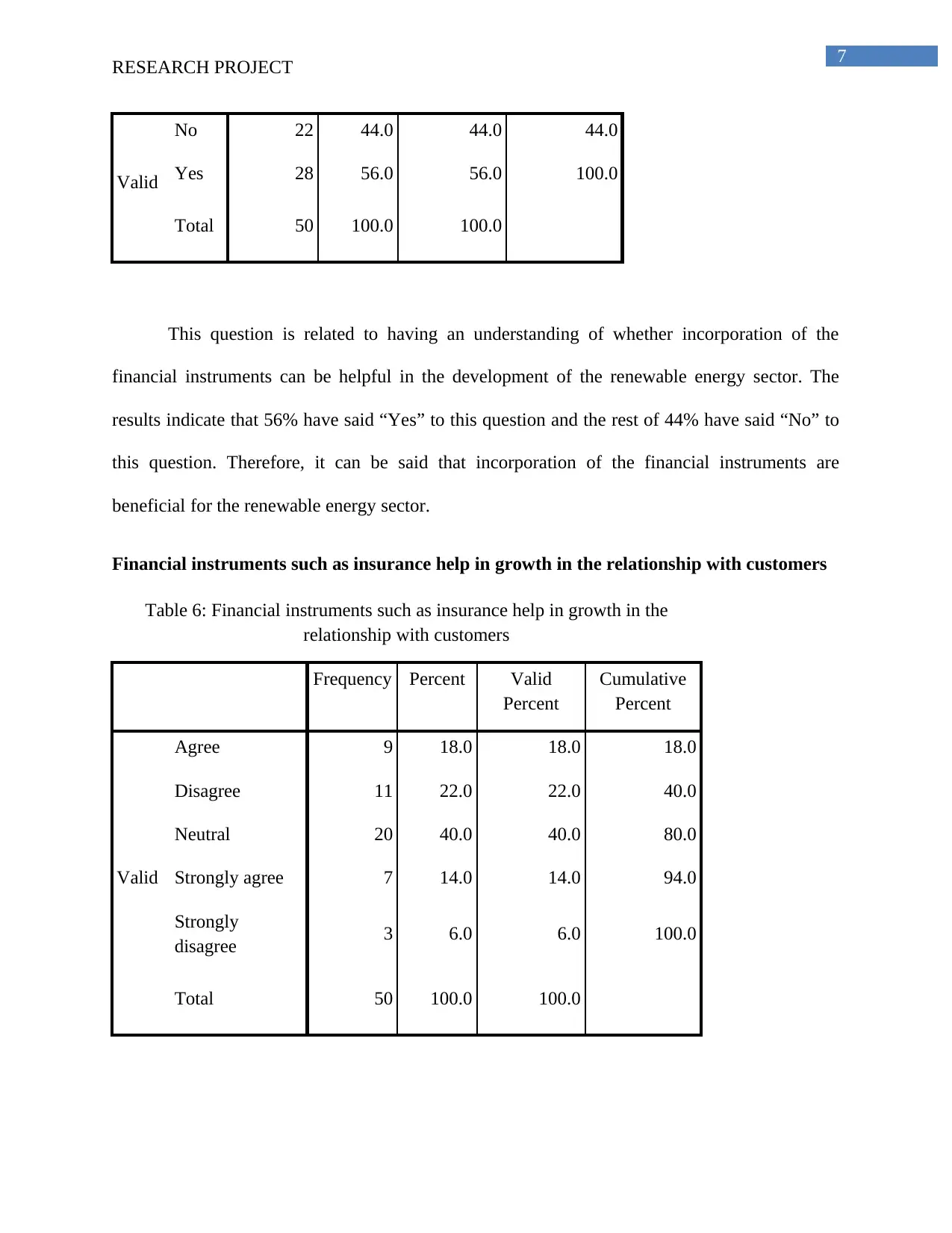
7
RESEARCH PROJECT
Valid
No 22 44.0 44.0 44.0
Yes 28 56.0 56.0 100.0
Total 50 100.0 100.0
This question is related to having an understanding of whether incorporation of the
financial instruments can be helpful in the development of the renewable energy sector. The
results indicate that 56% have said “Yes” to this question and the rest of 44% have said “No” to
this question. Therefore, it can be said that incorporation of the financial instruments are
beneficial for the renewable energy sector.
Financial instruments such as insurance help in growth in the relationship with customers
Table 6: Financial instruments such as insurance help in growth in the
relationship with customers
Frequency Percent Valid
Percent
Cumulative
Percent
Valid
Agree 9 18.0 18.0 18.0
Disagree 11 22.0 22.0 40.0
Neutral 20 40.0 40.0 80.0
Strongly agree 7 14.0 14.0 94.0
Strongly
disagree 3 6.0 6.0 100.0
Total 50 100.0 100.0
RESEARCH PROJECT
Valid
No 22 44.0 44.0 44.0
Yes 28 56.0 56.0 100.0
Total 50 100.0 100.0
This question is related to having an understanding of whether incorporation of the
financial instruments can be helpful in the development of the renewable energy sector. The
results indicate that 56% have said “Yes” to this question and the rest of 44% have said “No” to
this question. Therefore, it can be said that incorporation of the financial instruments are
beneficial for the renewable energy sector.
Financial instruments such as insurance help in growth in the relationship with customers
Table 6: Financial instruments such as insurance help in growth in the
relationship with customers
Frequency Percent Valid
Percent
Cumulative
Percent
Valid
Agree 9 18.0 18.0 18.0
Disagree 11 22.0 22.0 40.0
Neutral 20 40.0 40.0 80.0
Strongly agree 7 14.0 14.0 94.0
Strongly
disagree 3 6.0 6.0 100.0
Total 50 100.0 100.0
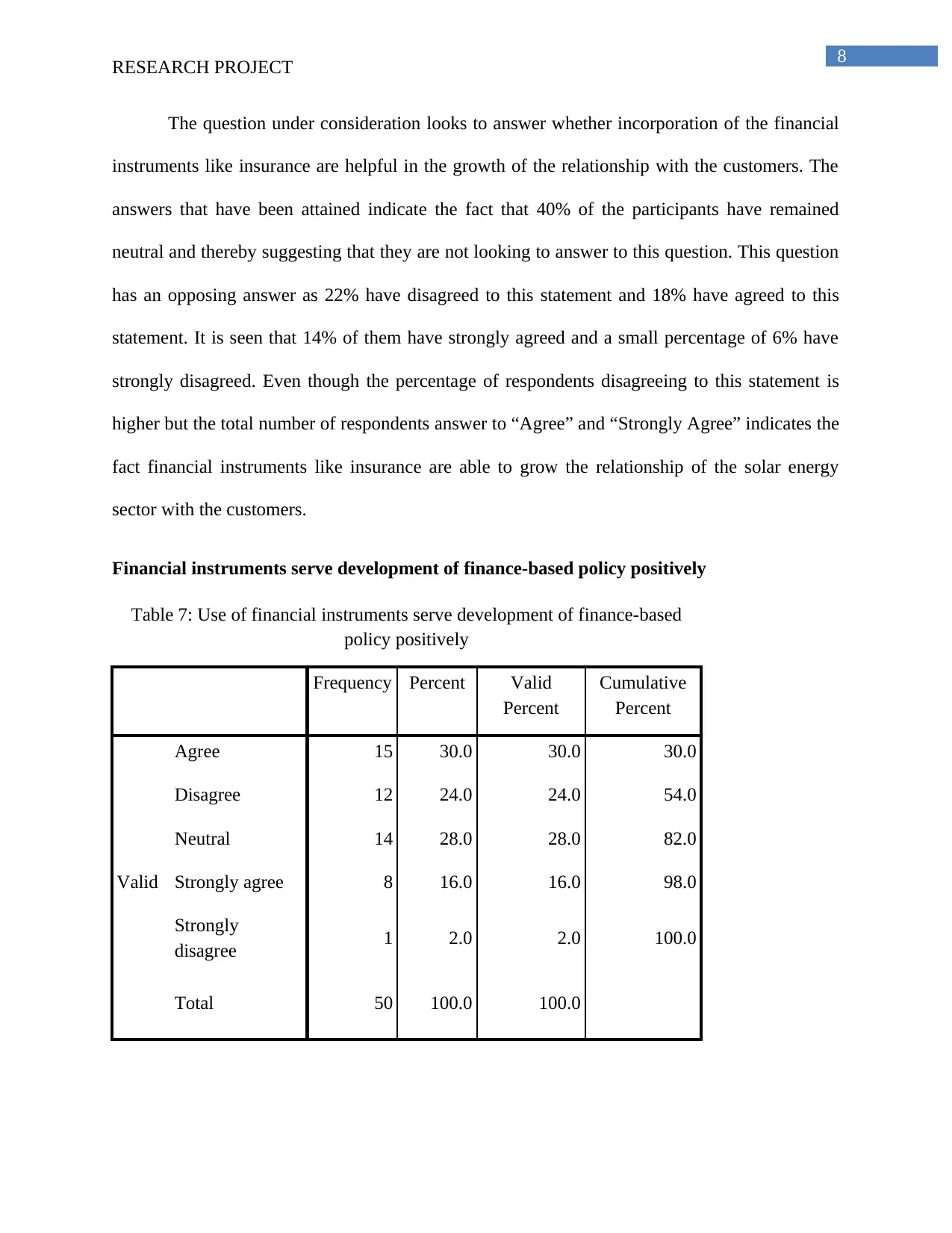
8
RESEARCH PROJECT
The question under consideration looks to answer whether incorporation of the financial
instruments like insurance are helpful in the growth of the relationship with the customers. The
answers that have been attained indicate the fact that 40% of the participants have remained
neutral and thereby suggesting that they are not looking to answer to this question. This question
has an opposing answer as 22% have disagreed to this statement and 18% have agreed to this
statement. It is seen that 14% of them have strongly agreed and a small percentage of 6% have
strongly disagreed. Even though the percentage of respondents disagreeing to this statement is
higher but the total number of respondents answer to “Agree” and “Strongly Agree” indicates the
fact financial instruments like insurance are able to grow the relationship of the solar energy
sector with the customers.
Financial instruments serve development of finance-based policy positively
Table 7: Use of financial instruments serve development of finance-based
policy positively
Frequency Percent Valid
Percent
Cumulative
Percent
Valid
Agree 15 30.0 30.0 30.0
Disagree 12 24.0 24.0 54.0
Neutral 14 28.0 28.0 82.0
Strongly agree 8 16.0 16.0 98.0
Strongly
disagree 1 2.0 2.0 100.0
Total 50 100.0 100.0
RESEARCH PROJECT
The question under consideration looks to answer whether incorporation of the financial
instruments like insurance are helpful in the growth of the relationship with the customers. The
answers that have been attained indicate the fact that 40% of the participants have remained
neutral and thereby suggesting that they are not looking to answer to this question. This question
has an opposing answer as 22% have disagreed to this statement and 18% have agreed to this
statement. It is seen that 14% of them have strongly agreed and a small percentage of 6% have
strongly disagreed. Even though the percentage of respondents disagreeing to this statement is
higher but the total number of respondents answer to “Agree” and “Strongly Agree” indicates the
fact financial instruments like insurance are able to grow the relationship of the solar energy
sector with the customers.
Financial instruments serve development of finance-based policy positively
Table 7: Use of financial instruments serve development of finance-based
policy positively
Frequency Percent Valid
Percent
Cumulative
Percent
Valid
Agree 15 30.0 30.0 30.0
Disagree 12 24.0 24.0 54.0
Neutral 14 28.0 28.0 82.0
Strongly agree 8 16.0 16.0 98.0
Strongly
disagree 1 2.0 2.0 100.0
Total 50 100.0 100.0
⊘ This is a preview!⊘
Do you want full access?
Subscribe today to unlock all pages.

Trusted by 1+ million students worldwide
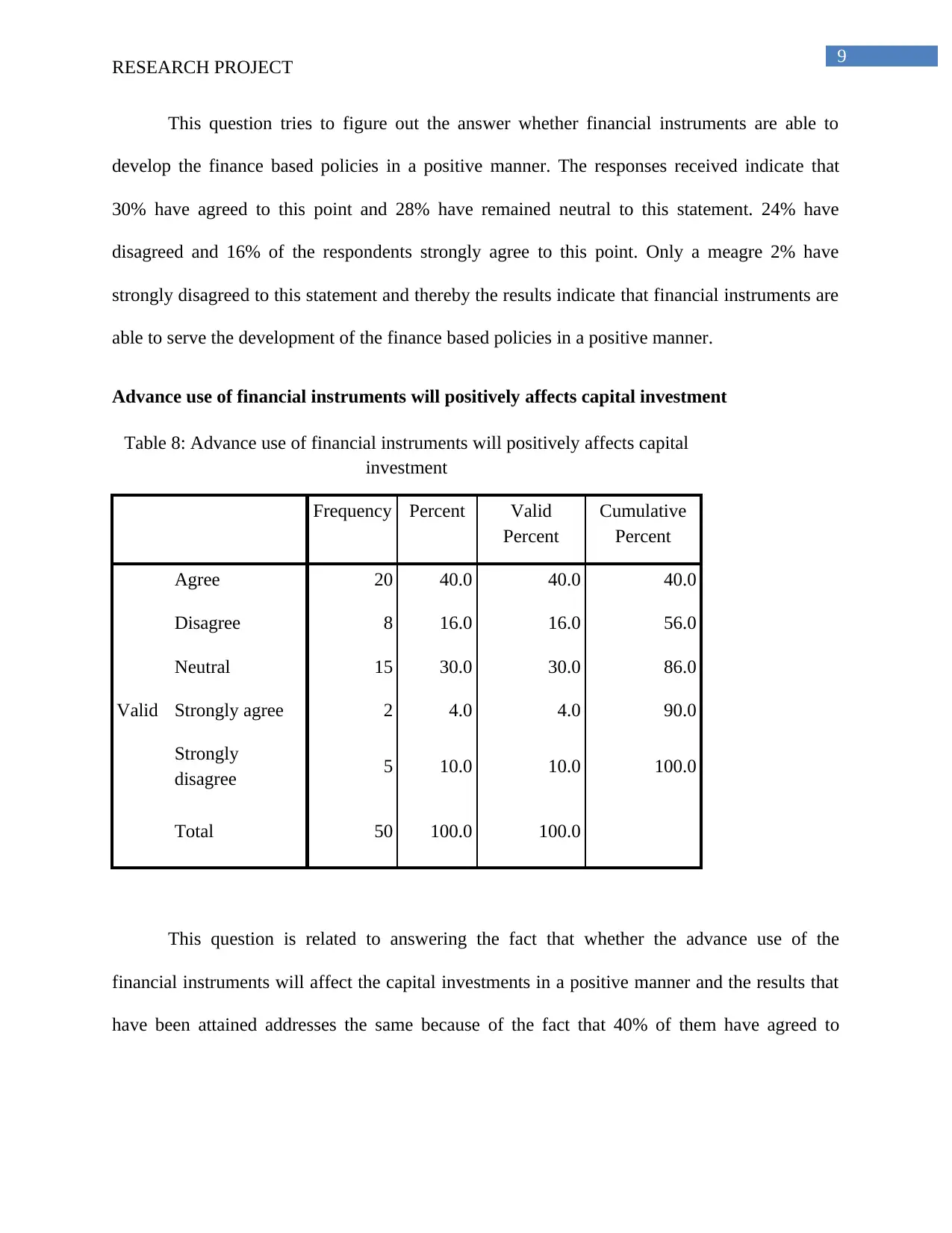
9
RESEARCH PROJECT
This question tries to figure out the answer whether financial instruments are able to
develop the finance based policies in a positive manner. The responses received indicate that
30% have agreed to this point and 28% have remained neutral to this statement. 24% have
disagreed and 16% of the respondents strongly agree to this point. Only a meagre 2% have
strongly disagreed to this statement and thereby the results indicate that financial instruments are
able to serve the development of the finance based policies in a positive manner.
Advance use of financial instruments will positively affects capital investment
Table 8: Advance use of financial instruments will positively affects capital
investment
Frequency Percent Valid
Percent
Cumulative
Percent
Valid
Agree 20 40.0 40.0 40.0
Disagree 8 16.0 16.0 56.0
Neutral 15 30.0 30.0 86.0
Strongly agree 2 4.0 4.0 90.0
Strongly
disagree 5 10.0 10.0 100.0
Total 50 100.0 100.0
This question is related to answering the fact that whether the advance use of the
financial instruments will affect the capital investments in a positive manner and the results that
have been attained addresses the same because of the fact that 40% of them have agreed to
RESEARCH PROJECT
This question tries to figure out the answer whether financial instruments are able to
develop the finance based policies in a positive manner. The responses received indicate that
30% have agreed to this point and 28% have remained neutral to this statement. 24% have
disagreed and 16% of the respondents strongly agree to this point. Only a meagre 2% have
strongly disagreed to this statement and thereby the results indicate that financial instruments are
able to serve the development of the finance based policies in a positive manner.
Advance use of financial instruments will positively affects capital investment
Table 8: Advance use of financial instruments will positively affects capital
investment
Frequency Percent Valid
Percent
Cumulative
Percent
Valid
Agree 20 40.0 40.0 40.0
Disagree 8 16.0 16.0 56.0
Neutral 15 30.0 30.0 86.0
Strongly agree 2 4.0 4.0 90.0
Strongly
disagree 5 10.0 10.0 100.0
Total 50 100.0 100.0
This question is related to answering the fact that whether the advance use of the
financial instruments will affect the capital investments in a positive manner and the results that
have been attained addresses the same because of the fact that 40% of them have agreed to
Paraphrase This Document
Need a fresh take? Get an instant paraphrase of this document with our AI Paraphraser
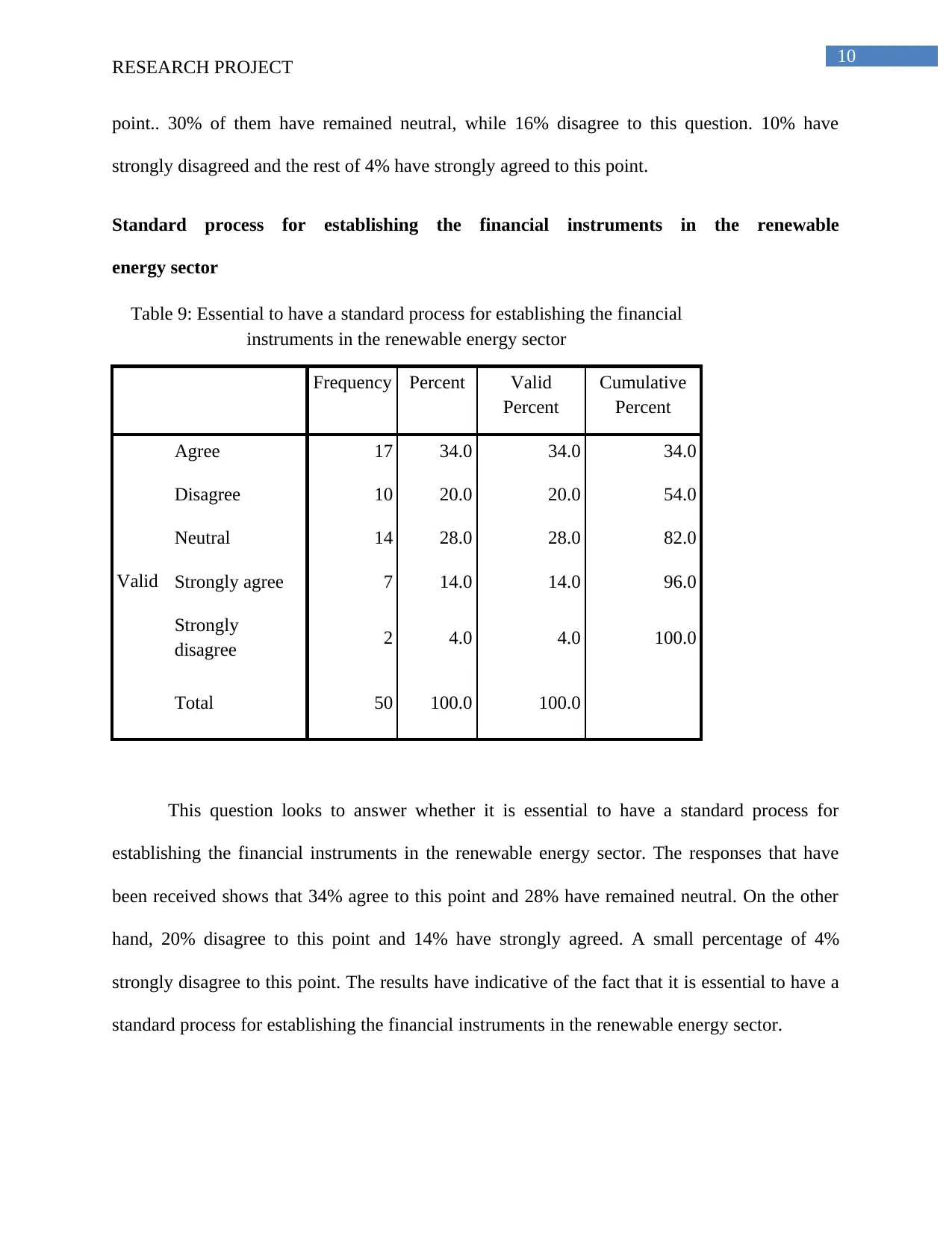
10
RESEARCH PROJECT
point.. 30% of them have remained neutral, while 16% disagree to this question. 10% have
strongly disagreed and the rest of 4% have strongly agreed to this point.
Standard process for establishing the financial instruments in the renewable
energy sector
Table 9: Essential to have a standard process for establishing the financial
instruments in the renewable energy sector
Frequency Percent Valid
Percent
Cumulative
Percent
Valid
Agree 17 34.0 34.0 34.0
Disagree 10 20.0 20.0 54.0
Neutral 14 28.0 28.0 82.0
Strongly agree 7 14.0 14.0 96.0
Strongly
disagree 2 4.0 4.0 100.0
Total 50 100.0 100.0
This question looks to answer whether it is essential to have a standard process for
establishing the financial instruments in the renewable energy sector. The responses that have
been received shows that 34% agree to this point and 28% have remained neutral. On the other
hand, 20% disagree to this point and 14% have strongly agreed. A small percentage of 4%
strongly disagree to this point. The results have indicative of the fact that it is essential to have a
standard process for establishing the financial instruments in the renewable energy sector.
RESEARCH PROJECT
point.. 30% of them have remained neutral, while 16% disagree to this question. 10% have
strongly disagreed and the rest of 4% have strongly agreed to this point.
Standard process for establishing the financial instruments in the renewable
energy sector
Table 9: Essential to have a standard process for establishing the financial
instruments in the renewable energy sector
Frequency Percent Valid
Percent
Cumulative
Percent
Valid
Agree 17 34.0 34.0 34.0
Disagree 10 20.0 20.0 54.0
Neutral 14 28.0 28.0 82.0
Strongly agree 7 14.0 14.0 96.0
Strongly
disagree 2 4.0 4.0 100.0
Total 50 100.0 100.0
This question looks to answer whether it is essential to have a standard process for
establishing the financial instruments in the renewable energy sector. The responses that have
been received shows that 34% agree to this point and 28% have remained neutral. On the other
hand, 20% disagree to this point and 14% have strongly agreed. A small percentage of 4%
strongly disagree to this point. The results have indicative of the fact that it is essential to have a
standard process for establishing the financial instruments in the renewable energy sector.
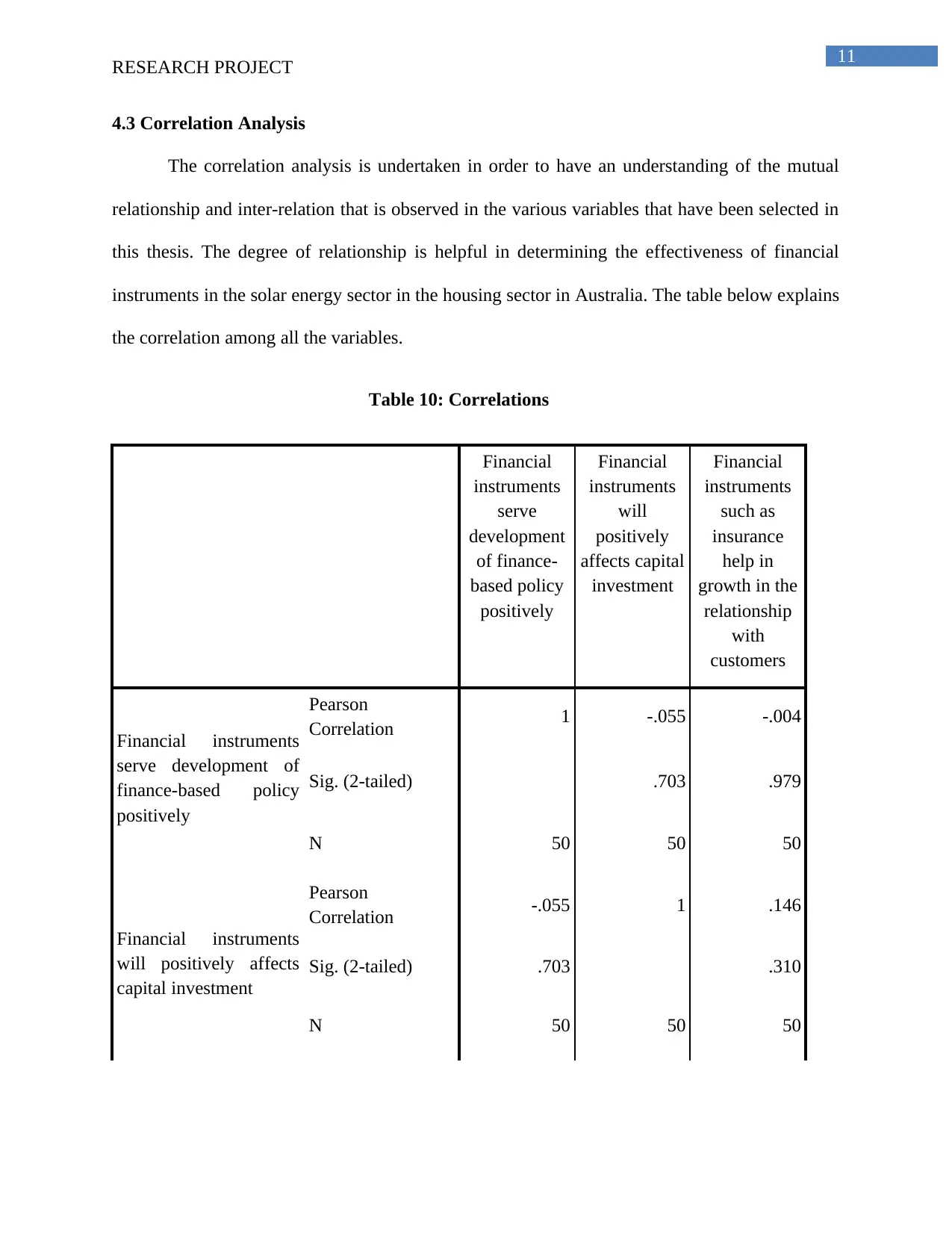
11
RESEARCH PROJECT
4.3 Correlation Analysis
The correlation analysis is undertaken in order to have an understanding of the mutual
relationship and inter-relation that is observed in the various variables that have been selected in
this thesis. The degree of relationship is helpful in determining the effectiveness of financial
instruments in the solar energy sector in the housing sector in Australia. The table below explains
the correlation among all the variables.
Table 10: Correlations
Financial
instruments
serve
development
of finance-
based policy
positively
Financial
instruments
will
positively
affects capital
investment
Financial
instruments
such as
insurance
help in
growth in the
relationship
with
customers
Financial instruments
serve development of
finance-based policy
positively
Pearson
Correlation 1 -.055 -.004
Sig. (2-tailed) .703 .979
N 50 50 50
Financial instruments
will positively affects
capital investment
Pearson
Correlation -.055 1 .146
Sig. (2-tailed) .703 .310
N 50 50 50
RESEARCH PROJECT
4.3 Correlation Analysis
The correlation analysis is undertaken in order to have an understanding of the mutual
relationship and inter-relation that is observed in the various variables that have been selected in
this thesis. The degree of relationship is helpful in determining the effectiveness of financial
instruments in the solar energy sector in the housing sector in Australia. The table below explains
the correlation among all the variables.
Table 10: Correlations
Financial
instruments
serve
development
of finance-
based policy
positively
Financial
instruments
will
positively
affects capital
investment
Financial
instruments
such as
insurance
help in
growth in the
relationship
with
customers
Financial instruments
serve development of
finance-based policy
positively
Pearson
Correlation 1 -.055 -.004
Sig. (2-tailed) .703 .979
N 50 50 50
Financial instruments
will positively affects
capital investment
Pearson
Correlation -.055 1 .146
Sig. (2-tailed) .703 .310
N 50 50 50
⊘ This is a preview!⊘
Do you want full access?
Subscribe today to unlock all pages.

Trusted by 1+ million students worldwide
1 out of 33
Your All-in-One AI-Powered Toolkit for Academic Success.
+13062052269
info@desklib.com
Available 24*7 on WhatsApp / Email
![[object Object]](/_next/static/media/star-bottom.7253800d.svg)
Unlock your academic potential
Copyright © 2020–2025 A2Z Services. All Rights Reserved. Developed and managed by ZUCOL.

